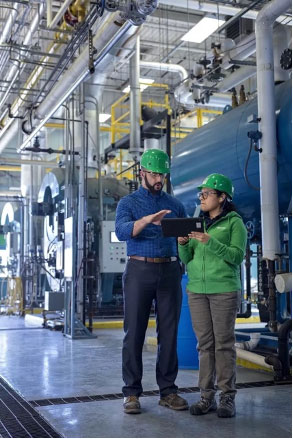The industrial sector is challenging to decarbonize, which is precisely why stakeholders must focus on that arena.
By: Poonam Narang, Product Management Director at Schneider Electric
To meet climate goals, global stakeholders must digitize sectors that contribute most heavily to carbon emissions and energy consumption.
To meet urgent climate goals, such as net-zero carbon emissions by 2050, global stakeholders must focus on sectors that contribute most heavily to carbon emissions and energy consumption. The global industrial sector, for example, consumes more than one-third of the world’s natural gas, seven percent of its oil and vast quantities of coal. The bottom line: decarbonizing the industry is a crucial step towards meeting global climate goals.
This task will not be easy, however. Much of the sector’s emissions come from heating fossil fuels and using that heat as feedstock to produce things like steel, cement, and chemicals producing substantial emissions. Electrifying heating processes could alter the composition of those processes, creating complications during production. It’s true that the industrial sector has a hard-to-tackle decarbonization problem, which is why the sector should serve as a lighthouse for other economic areas, such as energy and materials industries.
Stakeholders can reduce industry’s carbon emissions by instead digitizing and retrofitting physical assets. Digital tools turn assets into smart machines, improving visibility and helping firms better monitor and optimize energy use, reducing carbon emissions and energy consumption.

The World Economic Forum believes implementing digital technologies at scale in energy, materials and mobility industries may reduce global emissions by 20% by 2050. Some organizations have already demonstrated just how digital tools can help improve industrial efficiency without compromising delicate parts of the production chain.
One food equipment manufacturer, for example, had aging electrical motors in its equipment. The older motors used electricity inefficiently as equipment requires maintenance. However, this may not be obvious to the naked eye. Additionally overload relays trip from time to time, causing downtime. As the connection between power systems and industrial processes, the electric motors and systems they drive are the largest single-energy end use and account for more than 40% of global electricity consumption. Understanding how they function in different environments is crucial to improving energy efficiency, but manufacturers must first turn motors into intelligent machines to acquire this information.
With the help of a system integrator, the manufacturer implemented a load management solution. The solution switches, protects and manages motors and other electrical loads in an electrical control panel. It monitors motors and other assets to deliver alerts and insights and enable remote management. The digital load management solution also allows the manufacturer to proactively schedule maintenance based on run time and performance.
Solutions like monitor-enabled switchgear reduce modernization downtime and simplify integration with third-party automation. For Evian, it also reduced their costs and decreased the environmental impact of modernization, preserving the factory’s efficiency and the water itself. By introducing visibility and futureproofing assets, Evian saved more than 300 metric tons of CO2 in part by reducing its energy consumption by 34% per liter of water.
Evian upgraded its old switchgear to protect factory equipment from electrical overload and retrofitted others with sensors. Sensor-enabled electrical equipment empowers firms with around-the-clock remote monitoring, unlocking predictive maintenance and innovative service plans. For Evian, the newer switchgear solution ensures the company can simply replace circuit breakers, rather than the entire component, in the future.
Digital solutions embed intelligence into asset control. Intelligence on the factory floor empowers firms with proactive asset protection and dynamically adaptable equipment based on data insights. These insights help mitigate shortcomings of traditional control methods, including unplanned downtime, carbon impact and reduced productivity.
Evian and the food equipment manufacturer’s digitization efforts are just two examples of the ways the industry can reduce emissions.
Other organizations can follow their lead. Industrial firms can begin digital transformation journeys by including smart technologies and visibility into motor-driven systems in modernization specs. Electrical load management systems, like those Evian and the manufacturer implemented, adapt to a wide variety of applications across many industries. By serving actionable data about equipment energy waste, these systems help optimize operations by monitoring critical equipment and providing visibility and control consistent with today’s operational and revenue expectations.
Digitalization of motor systems in this manner creates smarter machines and smarter machines create efficiencies to help solve industrial sector challenges. Smarter, optimized machines help reduce energy consumption and accelerate the path to net zero.
The Department of Energy proposes additional ways firms can update their operations to meet sustainability goals, many of which point to electricity 4.0 as the solution.
To further enhance the impact of intelligent machines, industrial firms can also adopt electricity-powered assets, such as electric motors and heat pumps. Electric components tend to be lighter weight, have a smaller footprint and longer lifespan than traditional combustion-powered counterparts. Each of these recommendations relies on digital tools to monitor, gather data, analyze performance, and optimize energy use.
To ensure transformation initiatives have maximum effect, firms can integrate digitized machines with software systems that manage factory operations. For example, energy-efficient contactors feed, control and protect electric motors. Contactors designed for perfect integration into control systems can be used to create motor starters for almost any type of application. One firm leveraged these energy efficient contactors for equipment integration to save 669 tons of CO2 and 1.8GWh of energy.
Digitizing industrial processes and equipment yields gains in operational efficiency and total cost of ownership without sacrificing the quality of processes or assets. Better yet, the equipment needed — electric assets, monitors, and software systems that help with predictive maintenance and energy optimization — already exist and can often be implemented while avoiding major disruption.
Digitizing assets like electric motors and power infrastructure has the ability to improve the carbon emissions across the entire sector, one in dire need of sustainable retrofitting. Industrial companies embracing decarbonization practices may also have a major domino effect. After all, if this hard-to-decarbonize sector can make headway, what’s to stop other corners of the economy from following suit?

Poonam Narang is the Director of Product Management for Motor Management solutions for Schneider Electric, North America. She is passionate about solving customer problems through digital and sustainable solutions while moving her customers forward in their Industry 4.0 journey. Narang has over 15 years of combined experience in sales, strategy, business development and product management and has been with Schneider Electric for 4.5 years. Poonam holds a Masters in Business Administration from Wake Forest University and a Bachelors in Engineering from Mumbai University.
In this episode, I sat down with Beejan Giga, Director | Partner and Caleb Emerson, Senior Results Manager at Carpedia International. We discussed the insights behind their recent Industry Today article, “Thinking Three Moves Ahead” and together we explored how manufacturers can plan more strategically, align with their suppliers, and build the operational discipline needed to support intentional, sustainable growth. It was a conversation packed with practical perspectives on navigating a fast-changing industry landscape.